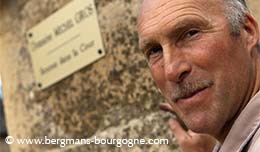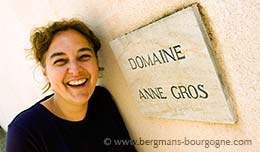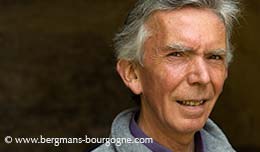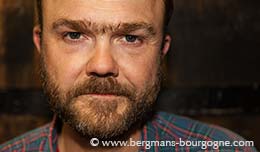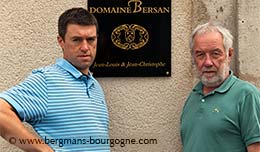
ust next to Santenay, only a 15-minute drive from Chassagne-Montrachet, is Dezize-lès-Maranges. Recently Bertrand Bachelet took on the family domaine here, added a few vineyards and set out to make the Maranges appellation more well-known.
– Maranges is not a very well-known appellation, says Bertrand Bachelet. It’s quite easy to sell in France, but internationally it doesn’t quite have the reputation. People are familiar with Santenay and Chassagne-Montrachet. Less so with Maranges. It doesn’t have the same ring to it yet as Pommard or Meursault.
 What used to be Domaine Jean-Louis Bachelet has now been transformed into Domaine Bertrand Bachelet. It covers eleven hectares, of which close to five are located within the Maranges appellation.
What used to be Domaine Jean-Louis Bachelet has now been transformed into Domaine Bertrand Bachelet. It covers eleven hectares, of which close to five are located within the Maranges appellation.
– I worked with my father up until 2010, explains Bertrand Bachelet. He retired that year, so 2011 was my first vintage. But he is still around, helping out.
For many years Jean-Louis Bachelet worked with his two brothers Vincent and Jean-François at the domaine created by their father – Domaine Bernard Bachelet in Chassagne-Montrachet. In 2008 they decided to split the domaine in three.
 – For me it was an easy choice becoming a winegrower, says Bertrand Bachelet. Already as a kid I would be with my father out on the tractor. I went to wine school in Beaune and then came back to the domaine in 2008. I took on three and a half hectares of vines that I would sell as grapes.
– For me it was an easy choice becoming a winegrower, says Bertrand Bachelet. Already as a kid I would be with my father out on the tractor. I went to wine school in Beaune and then came back to the domaine in 2008. I took on three and a half hectares of vines that I would sell as grapes.
– I also did internships. In the Rhône valley at Château Mont-Redon and in Rully at Vincent Dureuil’s domaine. He’s very good. I never got the chance to work abroad since I found vines to buy.
Maranges is part of the Côte de Beaune. Technically it is not part of the Côte d’Or; it is located in the departement of Saône-et-Loire, but is often included with the Côte d’Or when it comes to wine. The appellation as a whole covers about 180 hectares, including 83 hectares of premier cru land.
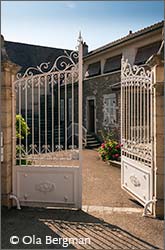 – 80 per cent of the Maranges production is red, says Bertrand Bachelet. There are three communes – Sampigny-lès-Maranges, Dezize-lès-Maranges and Cheilly-lès-Maranges – but only one appellation. White Maranges is coming strongly. Demand is increasing, so much land is being replanted with chardonnay instead of pinot noir. For the moment I only have 0,11 hectare of Maranges premier cru La Fussière, which is an annual production of just 600 bottles. But the plan is to plant more next year.
– 80 per cent of the Maranges production is red, says Bertrand Bachelet. There are three communes – Sampigny-lès-Maranges, Dezize-lès-Maranges and Cheilly-lès-Maranges – but only one appellation. White Maranges is coming strongly. Demand is increasing, so much land is being replanted with chardonnay instead of pinot noir. For the moment I only have 0,11 hectare of Maranges premier cru La Fussière, which is an annual production of just 600 bottles. But the plan is to plant more next year.
The red domination is also reflected at Domaine Bertrand Bachelet. Out of the eleven hectares only two are white. Maranges – village appellation in red, premier cru Clos Roussots in red and premier cru La Fussière in both colours – is a large part of the domaine, but there are also vines in Chassagne-Montrachet, Meursault, Santenay, Pommard and the Hautes-Côtes.
 – In 2010 I also bought some premier cru land in Saint-Aubin, in Les Cortons, says Bertrand Bachelet. I have planted chardonnay there and the first vintage will be 2014.
– In 2010 I also bought some premier cru land in Saint-Aubin, in Les Cortons, says Bertrand Bachelet. I have planted chardonnay there and the first vintage will be 2014.
– The largest parcel we have in Maranges is two and a half hectares in La Fussière. When you drive from Santenay to Dezize-lès-Maranges you have La Fussiére on your right as you approach the village and our other premier cru Clos Roussots on your left.
– La Fussiére is at the top of the slope. Steeper than Clos Roussots. As a wine it is rounder, perhaps with a bit more finesse. The soil is more chalky. In Clos Roussots, down below, the soil is deeper and contains more clay. Our parcel in Clos Roussots was planted in 1957 by my grandfather, so the yield is low. Maranges is like Pommard, it’s a wine with body.
 Domaine Bertrand Bachelet’s vines in Meursault Clos du Cromin are considerably older. They were planted back in 1925, in a soil that is red and rich in iron.
Domaine Bertrand Bachelet’s vines in Meursault Clos du Cromin are considerably older. They were planted back in 1925, in a soil that is red and rich in iron.
– It is behind the camping in Meursault, says bertrand Bachelet. On the Volnay side of the village, where the whites tend to be richer and fatter. Not so much minerality, more opulence.
He has a small parcel Chassagne-Montrachet premier cru Morgeot. It is located in Les Fairendes, a part of Morgeot, but production is limited to 1000 bottles a year because of the size of the plot. Together with village appellation in both red and white Bertrand Bachelet has a total of 2,6 hectares in Chassagne-Montrachet.
– The red Chassagne-Montrachet is like the red Meursault. Not very well-known. The character of red Chassagne-Montrachet is kind of halfway between Maranges and Santenay. Our parcels are located in Les Lombardes and Les Benoites, at the bottom of the appellation. It is flat with deep, very rich, soil. The vines are 45–50 years old and we use cordon royat pruning.
Bertrand Bachelet tries to reduce the use of weedkillers as much as possible; he works along the lines of lutte raisonnée. The use of new oak is between 20 per cent and 50 per cent, depending on the appellation.
– For the Maranges I try not to extract too much, he says. These wines can be quite sturdy, so I try to bring out the fruit.
© 2013 Ola Bergman










